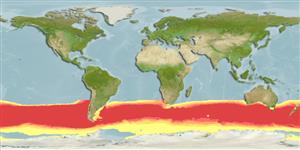Environment: milieu / climate zone / profondeur / distribution range
Écologie
marin bathypélagique; profondeur 44 - 2561 m (Ref. 6609). Deep-water; 30°S -
Circumglobal.
Taille / Poids / Âge
Maturité: Lm ? range ? - ? cm
Max length : 29.0 cm TL mâle / non sexé; (Ref. )
Description synthétique
Clés d'identification | Morphologie | Morphométrie
Épines dorsales (Total) : 0; Rayons mous dorsaux (Total) : 108; Épines anales: 0; Rayons mous anaux: 99; Vertèbres: 83. Pale brown or greyish in color (Ref. 6609).
Body shape (shape guide): elongated.
Mesopelagic (Ref. 75154).
Life cycle and mating behavior
Maturité | Reproduction | Frai | Œufs | Fécondité | Larves
Anderson, M.E., 1990. Zoarcidae. p. 256-276. In O. Gon and P.C. Heemstra (eds.) Fishes of the Southern Ocean. J.L.B. Smith Institute of Ichthyology, Grahamstown, South Africa. (Ref. 5197)
Statut dans la liste rouge de l'IUCN (Ref. 130435: Version 2025-1)
Menace pour l'homme
Harmless
Utilisations par l'homme
Pêcheries: bycatch
Outils
Articles particuliers
Télécharger en XML
Sources Internet
Estimates based on models
Preferred temperature (Réf.
123201): 1.9 - 8.7, mean 5.1 °C (based on 631 cells).
Phylogenetic diversity index (Réf.
82804): PD
50 = 0.5020 [Uniqueness, from 0.5 = low to 2.0 = high].
Bayesian length-weight: a=0.00316 (0.00135 - 0.00739), b=3.15 (2.94 - 3.36), in cm total length, based on LWR estimates for this (Sub)family-body shape (Ref.
93245).
Niveau trophique (Réf.
69278): 3.2 ±0.4 se; based on size and trophs of closest relatives
Résilience (Réf.
120179): Faible, temps minimum de doublement de population : 4,5 à 14 années (Preliminary K or Fecundity.).
Fishing Vulnerability (Ref.
59153): Low vulnerability (19 of 100).
🛈
